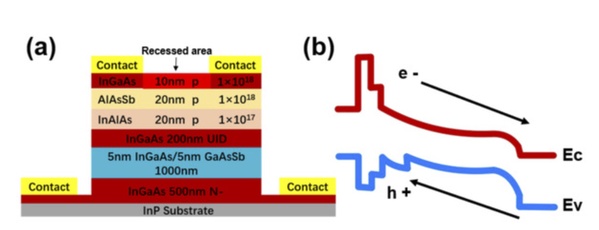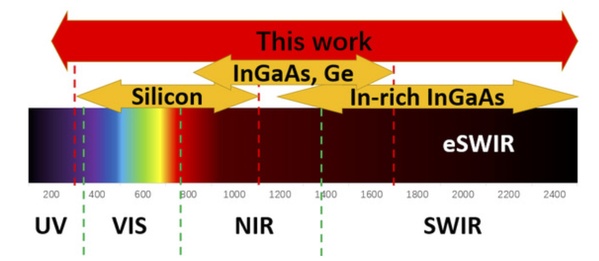Since different gases have different characteristic peaks, spectrum detection technology can be used to detect various gases. The current full-spectrum (from ultraviolet to infrared) detection technology usually utilizes multiple discrete detectors with different wavelength bands, thus the system is relatively complex, with an unsatisfactory performance, high dark currents, and rare response spectra spanning multiple bands.
ShanghaiTech researchers from SIST PMICC for the first time have achieved ultra-broad spectral responses ranging from ultraviolet, visible, near-infrared to extended short-wave infrared at room temperature by using only a single photodetector. Their results were recently published in the journal IEEE Electron Device Letters in the field of semiconductor devices.
In order to make the full-spectrum detector with a wider spectral response, lower dark current, and operation at room temperature, the research team led by Associate Professor Chen Baile successfully developed a new scheme for wide-spectrum detectors of InP-based InGaAs and InGaAs/GaAsSb type II superlattice materials. In their proposed scheme, an AlAsSb electron blocking layer and an InAlAs transition layer were innovatively designed in the P region with a thickness of 50nm. The detectable wavelength band of the proposed photodetector can range from ultraviolet in the short-wave direction, to extended short-wave infrared in the long-wave direction.

(a)Schematic diagram of device cross-sectional structure and epitaxial structure (b) Device energy band structure diagram
The experimental test results showed that this device can achieve a detection range from 250 nm to 2.5μm at room temperature, and the highest detectivity reaches 6.45×1010cm·Hz1/2/W. Compared with other detectors reported so far, this photodetector has a larger spectral response range and has great application potential in related fields such as full-spectrum inspection.

The comparison between the spectral detection range of this proposed device and the range of silicon, InGaAs, Ge, and In-rich InGaAs detectors
The research was co-conducted by ShanghaiTech and SIMIT, CAS. Wang Jingyi, a SIST second year master student, is the first author of the research paper “InP-Based Broadband Photodetectors With InGaAs/GaAsSb Type-II Superlattice”, and Prof. Chen is the corresponding author.

